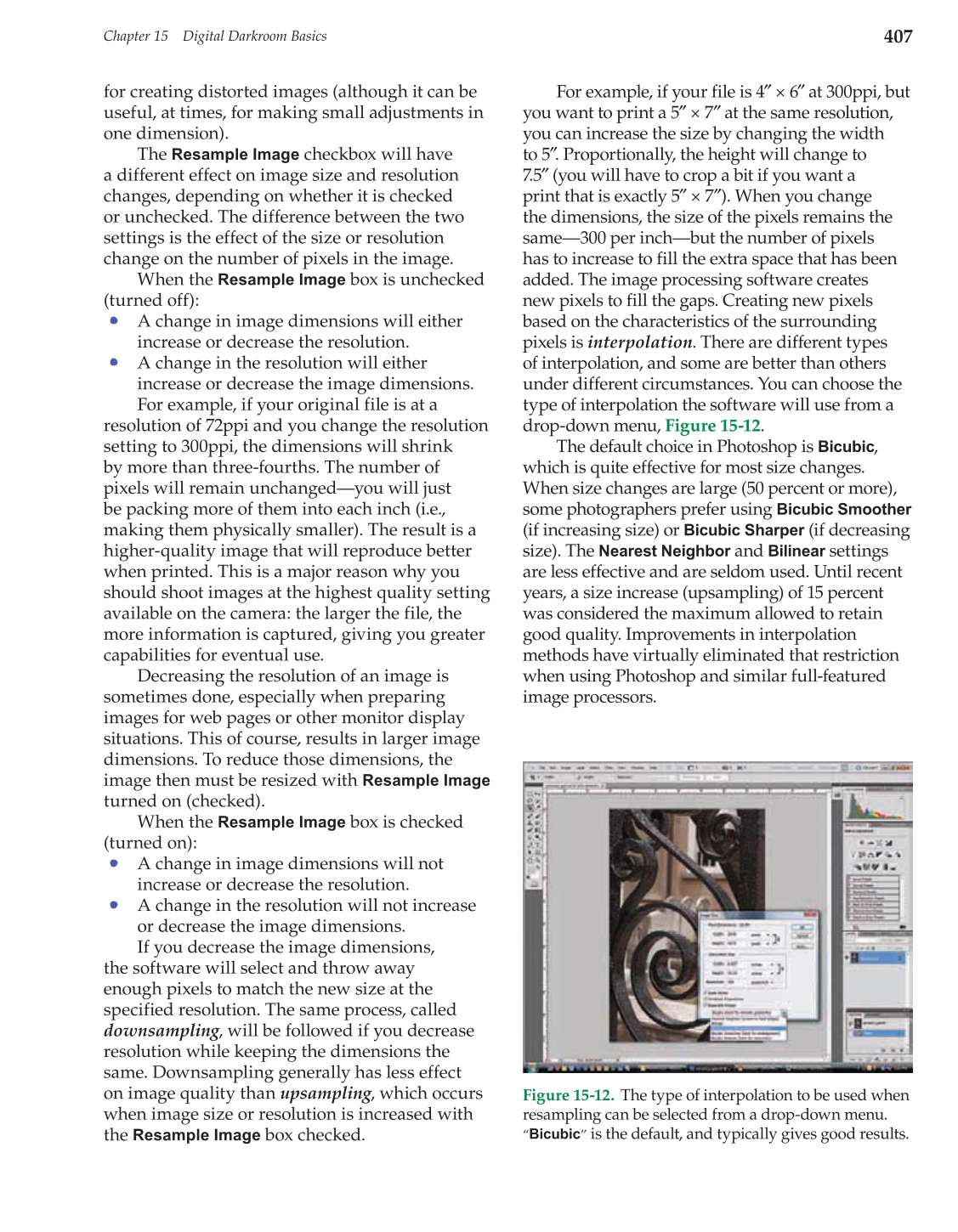Chapter 15 Digital Darkroom Basics
407
for creating distorted images (although it can be
useful, at times, for making small adjustments in
one dimension).
The
Resample Image
checkbox will have
a different effect on image size and resolution
changes, depending on whether it is checked
or unchecked. The difference between the two
settings is the effect of the size or resolution
change on the number of pixels in the image.
When the
Resample Image
box is unchecked
(turned off):
• A change in image dimensions will either
increase or decrease the resolution.
• A change in the resolution will either
increase or decrease the image dimensions.
For example, if your original file is at a
resolution of 72ppi and you change the resolution
setting to 300ppi, the dimensions will shrink
by more than three-fourths. The number of
pixels will remain unchanged—you will just
be packing more of them into each inch (i.e.,
making them physically smaller). The result is a
higher-quality image that will reproduce better
when printed. This is a major reason why you
should shoot images at the highest quality setting
available on the camera: the larger the file, the
more information is captured, giving you greater
capabilities for eventual use.
Decreasing the resolution of an image is
sometimes done, especially when preparing
images for web pages or other monitor display
situations. This of course, results in larger image
dimensions. To reduce those dimensions, the
image then must be resized with
Resample Image
turned on (checked).
When the
Resample Image
box is checked
(turned on):
• A change in image dimensions will not
increase or decrease the resolution.
• A change in the resolution will not increase
or decrease the image dimensions.
If you decrease the image dimensions,
the software will select and throw away
enough pixels to match the new size at the
specified resolution. The same process, called
downsampling, will be followed if you decrease
resolution while keeping the dimensions the
same. Downsampling generally has less effect
on image quality than upsampling, which occurs
when image size or resolution is increased with
the
Resample Image
box checked.
For example, if your file is 4″ × 6″ at 300ppi, but
you want to print a 5″ × 7″ at the same resolution,
you can increase the size by changing the width
to 5″. Proportionally, the height will change to
7.5″ (you will have to crop a bit if you want a
print that is exactly 5″ × 7″). When you change
the dimensions, the size of the pixels remains the
same—300 per inch—but the number of pixels
has to increase to fill the extra space that has been
added. The image processing software creates
new pixels to fill the gaps. Creating new pixels
based on the characteristics of the surrounding
pixels is interpolation. There are different types
of interpolation, and some are better than others
under different circumstances. You can choose the
type of interpolation the software will use from a
drop-down menu, Figure 15-12.
The default choice in Photoshop is Bicubic,
which is quite effective for most size changes.
When size changes are large (50 percent or more),
some photographers prefer using
Bicubic Smoother
(if increasing size) or
Bicubic Sharper
(if decreasing
size). The
Nearest Neighbor
and
Bilinear
settings
are less effective and are seldom used. Until recent
years, a size increase (upsampling) of 15 percent
was considered the maximum allowed to retain
good quality. Improvements in interpolation
methods have virtually eliminated that restriction
when using Photoshop and similar full-featured
image processors.
Figure 15-12. The type of interpolation to be used when
resampling can be selected from a drop-down menu.
“Bicubic”
is the default, and typically gives good results.
